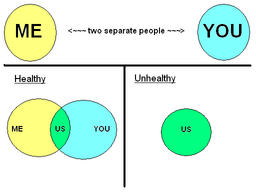Separation of Stuff
To put the example of Tom and Maria into a visual form, we use colored circles:

By utilizing our other tools - not taking anything personally, making no assumptions, untwisting our thinking, using our steps to gain a fresh perspective - we become adept at separating our stuff from the other person's stuff.
We allow the other person the right to see things the way they see them.
We allow the other person the right to hold differing opinions.
We allow the other person the right to have different priorities from ours.
We allow the other person the right to be themselves.
Traditionally, people with Borderline operate in the lower right corner, the full green circle. We figure if we're considerate in the grocery store, everyone should be and we get disproportionately angry at people who don't live up to our internal expectations. After all, they are us and they should be aware, considerate and everything else we hold ourselves to.
Historically, as people with Borderline first encounter the concepts of separation of stuff, they end up operating in the area across the top: completely distanced and separated from everyone around them. These people frequently tell others "That's your stuff, not mine" and there's little chance of genuine communication, understanding or growth during that phase.
It's only as we begin to fully integrate the concept that we're able to have interactions that are respectful of the boundaries around us, where we take responsibility for the stuff that's ours and work to achieve the healthy level of overlap between the two circles - as shown in the lower left corner. It is in that small sliver of overlapping circles that healthy relationships are found, nurtured and grow.


